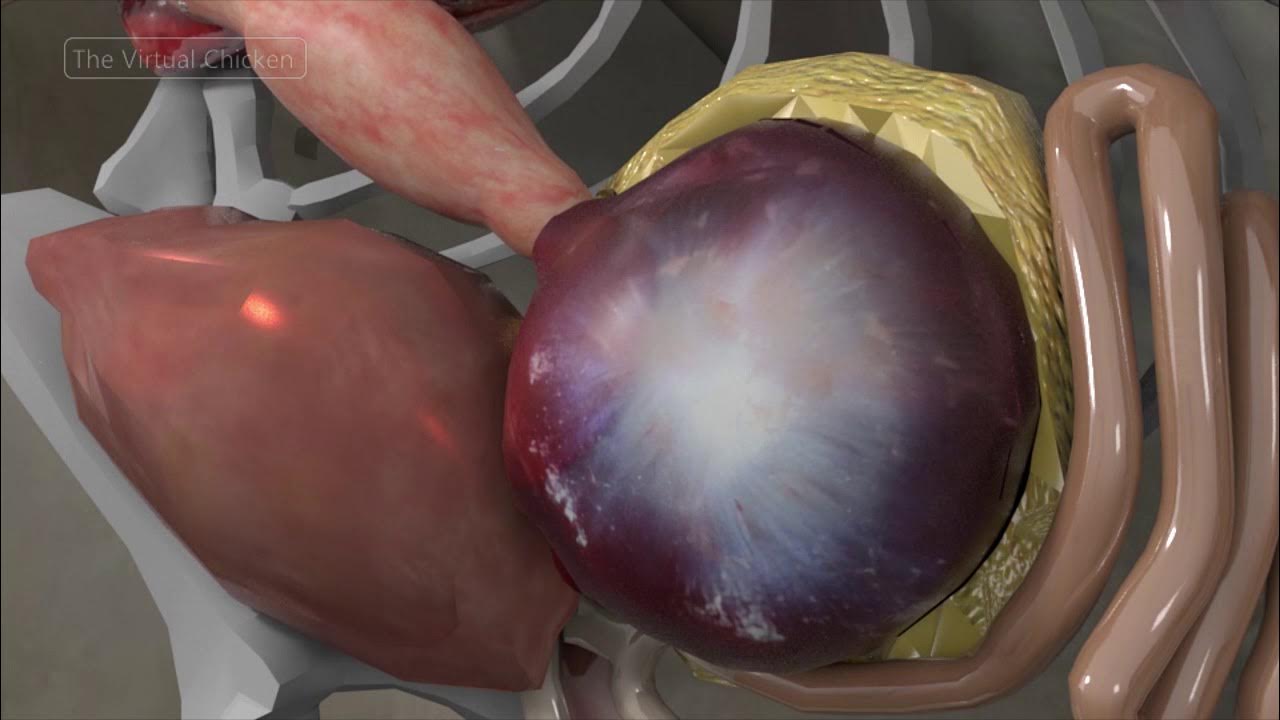Sistem Pencernaan Pada Ayam
Summary
TLDRThis transcript provides a detailed overview of the digestive system in chickens, starting from the beak and ending at the cloaca. It covers each organ in the digestive process, including the esophagus, crop, proventriculus, gizzard, small intestine, cecum, large intestine, and cloaca. The script explains how food is processed mechanically and enzymatically in these organs, highlighting the unique features of a chicken's digestive system, such as the lack of teeth and the function of the gizzard in grinding food. It also discusses the role of various enzymes in digestion and nutrient absorption.
Takeaways
- 😀 The digestive system of chickens starts from the beak and ends at the cloaca, involving several key organs.
- 😀 Chickens do not have true teeth; their beak and tongue help in food intake and pushing food down the esophagus.
- 😀 The esophagus functions as a tube that transports food from the mouth to the crop, with mucus secretion to aid in food movement.
- 😀 The crop is a pouch-like enlargement of the esophagus that temporarily stores food and helps in softening it before digestion.
- 😀 The proventriculus, also known as the true stomach, is where enzymatic digestion of proteins occurs with the help of hydrochloric acid and pepsin.
- 😀 The gizzard (ampela) is responsible for mechanical digestion, using ingested stones or grit to grind food.
- 😀 The small intestine is divided into three parts: the duodenum, jejunum, and ileum, where enzymes break down proteins, fats, and carbohydrates.
- 😀 Enzymes like amylase, lipase, and trypsin in the duodenum help digest starches, fats, and proteins respectively.
- 😀 The cecum is located between the small and large intestines and contains undigested food and some microbial digestion of fiber.
- 😀 The large intestine absorbs water from the digested food and regulates the water balance before waste is excreted through the cloaca.
Q & A
What is the first part of the digestive system in chickens?
-The first part of the digestive system in chickens is the beak, which is part of the mouth. Chickens do not have true teeth, so their beak helps them take in food.
What is the function of the esophagus in a chicken's digestive system?
-The esophagus serves as a channel for food to move from the mouth to the crop. It is lined with mucous membranes that help in food lubrication and uses peristaltic movements to push food along.
What is the role of the crop (tembolok) in chickens?
-The crop acts as a food storage pouch. It temporarily holds food to soften it before further digestion. It also helps in storing food until it can move to the proventriculus for enzyme digestion.
How does the proventriculus contribute to digestion in chickens?
-The proventriculus, also known as the true stomach, secretes digestive enzymes like hydrochloric acid and pepsin. These enzymes break down proteins in the food before it moves to the gizzard.
What is the function of the gizzard (ampela) in chickens?
-The gizzard mechanically grinds food with the help of grit (small stones) that chickens ingest. This process breaks down food into smaller particles, aiding further digestion.
What happens in the small intestine of chickens?
-In the small intestine, digestion is further carried out by enzymes from the pancreas, such as amylase, lipase, and trypsin. These enzymes break down proteins, fats, and carbohydrates into absorbable molecules.
What is the role of the appendix in chickens?
-The appendix, also known as the cecum, is located between the small and large intestines. Its function is not entirely clear, but it is thought to aid in the digestion of fibers and the absorption of some nutrients.
How does the large intestine function in chickens?
-The large intestine in chickens primarily functions in water reabsorption, which helps in maintaining fluid balance. It also prepares undigested food for excretion.
What is the cloaca in chickens and what is its purpose?
-The cloaca is the final part of the digestive system in chickens. It serves as a common exit for digestive waste, urine, and reproductive fluids. It has three openings: one for feces, one for urine, and one for reproductive functions.
How does the chicken's digestive system compensate for the lack of teeth?
-Since chickens lack teeth, their digestive system relies on the crop to soften food and the gizzard to mechanically grind it with the help of ingested grit. This ensures the food is properly broken down for digestion.
Outlines

This section is available to paid users only. Please upgrade to access this part.
Upgrade NowMindmap

This section is available to paid users only. Please upgrade to access this part.
Upgrade NowKeywords

This section is available to paid users only. Please upgrade to access this part.
Upgrade NowHighlights

This section is available to paid users only. Please upgrade to access this part.
Upgrade NowTranscripts

This section is available to paid users only. Please upgrade to access this part.
Upgrade NowBrowse More Related Video

The Poultry Digestive Tract

Virtual Chicken: The Mouth

ANHIST A3 - PRAKTIKUM ANATOMI DAN HISTOLOGI SISTEM PENCERNAAN PADA IKAN NILA (Oreochromis Niloticus)

C A Digestive System part 1

Virtual Chicken: Full Digestive System

PROSES PRODUKSI YAKULT YANG MELIBATKAN MIKROORGANISME - Lactobacillus casei Shirota strain
5.0 / 5 (0 votes)